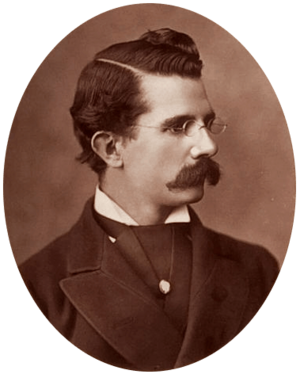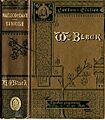William Black (novelist) facts for kids
Quick facts for kids
William Black
|
|
|---|---|
 |
|
| Born | 13 November 1841 Glasgow, Lanarkshire
|
| Died | 10 December 1898 (aged 57) Brighton, Sussex
|
| Nationality | Scottish |
| Occupation | novelist |
|
Notable work
|
A Daughter of Heth (1871) A Princess of Thule (1873) |
| Signature | |
William Black (born November 13, 1841 – died December 10, 1898) was a Scottish writer. He was born in Glasgow, Scotland. During his life, Black's books were very popular. People even compared them to the works of Anthony Trollope. However, his fame did not last long into the 1900s.
Contents
William Black's Life Story
William Black was born to James Black and Caroline Conning. He first studied to become a landscape painter. This training helped him a lot in his writing career. He became known for his detailed descriptions of nature and the sea in his novels. One example is White Wings: A Yachting Romance (1880).
When he was 23, William moved to London. He had already worked as a journalist in Glasgow. In London, he joined the staff of the Morning Star newspaper. Later, he worked for the Daily News, where he became an assistant editor. He also wrote a weekly story for The Graphic magazine. During the Austro-Prussian War, he worked as a war reporter.
Black's first novel, James Merle, came out in 1864. It was not very successful. Black later disliked this book and even bought copies to destroy them. Two more early novels, Love or Marriage (1868) and The Monarch of Mincing Lane (1871), did not help his career much. These three books were not included in the collection of his works published later.
His book A Daughter of Heth was published in 1871. This book made him very popular right away. It tells the story of a young girl raised in Catholic France. She moves to live with her strict Protestant relatives in southern Scotland. The story ends sadly. In 1872, he published a travel story called The Strange Adventures of a Phaeton. In 1874, A Princess of Thule was another huge success. This book was later turned into a musical play called The Maid of Arran by a young writer named L. Frank Baum.
From 1875, Black focused only on writing novels. He wrote several collections of short stories and 22 more novels. His last novel, Wild Eelin, was published in 1898, just before he passed away on December 10 of that year.
During his time, William Black's novels were very well-liked. Some people thought they were as good as those by Anthony Trollope. However, some critics felt his books focused too much on hunting and fishing. His popularity did not last long into the 20th century. In the United States, his books were copied and sold without his permission. This was because there were no strong copyright laws then. He worked with famous authors like Rudyard Kipling and Thomas Hardy to fight this problem. This led to new laws being passed in 1891. Unlike other writers, Black did not hold grudges against those who sold copies of his books when it was legal. This helped him have better relationships with his American publishers.
William Black also wrote a book about the writer Goldsmith (1878). This was for a series called English Men of Letters.
A lighthouse was built to remember Black. It looks like a Gothic tower. A plaque on the door says it was built "by his friends and admirers from all over the world." The lighthouse was built in 1901 and is still used today. It stands near Duart Castle on the Isle of Mull.
A collection of his short stories, including parts of his first book James Merle, was published after his death. It was called With the Eyes of Youth, and Other Sketches (1903).
William Black's Family Life
William Black's first wife, Augustus Wenzel, died on May 14, 1866. She got a fever shortly after their son, Martin, was born. They had only been married since April 8, 1865. Sadly, Martin also passed away on March 29, 1871.
Black first met his second wife, Eva Simpson, in 1869. She was the daughter of Wharton Simpson, who was also a journalist. He saw her again in 1872 and used her as inspiration for a character in his book The Phaeton. They got married in April 1874.
From 1879 until he died, Black lived at 1 Paston Place in Brighton.
How William Black Was Remembered
A special memorial for William Black was built at Duart Point. It looks like a small castle and was designed by an architect from Glasgow named William Leiper.
William Black's Books
|
Images for kids



